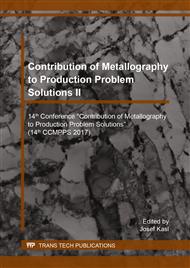p.107
p.112
p.118
p.124
p.130
p.136
p.142
p.149
p.156
Evaluation of Titanium Carbonitride Particles Using Image Analysis and Assessment of their Impact on Machinability
Abstract:
A car manufacturer makes crankshafts of materials from various suppliers. The steels from individual batches differed in their grinding behaviour, despite being supplied as a single steel grade. Some deliveries were repeatedly associated with much faster wear of grinding wheels than others. Consequently, the ground surfaces of the crankshafts developed visible patterns and, in some cases, surface cracks. The excessive wear in grinding wheels was suspected to be caused by titanium precipitates. The purpose of this investigation was to identify the phases in which titanium is present in the steels, describe the morphology, sizes and distribution of their particles and compare these aspects for materials from the three suppliers. It was found that titanium was present in the form of carbides or carbonitrides, whose morphology, sizes, distributions and quantities of particles varied greatly between the suppliers. These variations were identified as the cause of the differences in grinding behaviour.
Info:
Periodical:
Pages:
130-135
Citation:
Online since:
November 2017
Authors:
Price:
Сopyright:
© 2017 Trans Tech Publications Ltd. All Rights Reserved
Share:
Citation:


